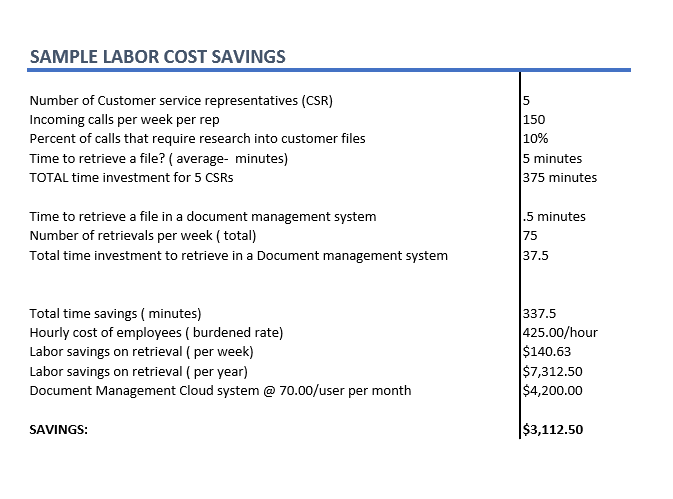5 Ways To Cost Justify A Document Management System

According to White House Senior Advisor Kevin Hasset this week, the outlook for the U.S. economy is grave. This will be a time, when companies reserve capital for the “must haves” instead of the “nice to haves”. Given this, WHY would a company choose to invest in a luxury like a document management system? They wouldn’t unless they knew it would save them money. With an investment like a document management system, where do you look for the savings?
To start, you must look at the difference between the current state of your operations and the expected future state. What does it cost you now to do this work, relative to the anticipated savings of a new way of working? Employee costs, storage, and misfiled documents all drive the administrative costs of a paper-based system. Let’s dig a little deeper.

Employee Costs
For most companies the biggest business expense is payroll expense. This is a cost you can break out per hour. If you can determine what it is costing you in time, you can translate that to dollars. The graphic shows the difference in a small five-person customer service department. Time to retrieve files, return phone calls, and then make fair decisions for both the company and the customer all incur cost.
Filing Costs
Handling paper can be expensive. There are supplies like staples, labels, folders, cabinets. There is also the cost of the physical space those files take up. Paper-based systems create labor around creating new files or adding to an existing one. To add a new document into an existing file, you must retrieve the folder. To add a new file, you must invest labor time to create it. With a document management system, you can build out a folder structure by simply attaching structured keywords to your documents and all of the corresponding documents that tie to them.
Real Estate Costs
These costs don’t apply to everyone, but for our clients in major metropolitan areas, office space is at a premium, and file cabinets take up space. Especially for frequently retrieved files that need to be close to the employees who retrieve them.
Lost/Misfiled Records Costs
Records generally are lost after they are retrieved, not during initial filing. Sometimes, the loss is temporary, as the record is simply not returned. Other times, records are misfiled. When this happens, the best case scenario is an increased time to retrieve. The worst case scenario is that you can’t find the record and must make decisions blindly. How much does this increased time to resolve issues cost you?
Soft Cost Benefits
Many benefits are not easily quantified to a whole dollar figure, but the value is there regardless. Consider the following:
- What is the benefit of time savings by allowing simultaneous access (not making multiple convenience copies)?
- How do you quantify when your employees are happier because they have what they need to do their best work?
- What about the value of retention management and not holding sensitive data longer than you need to? What would it cost your company if your customer’s sensitive data were exposed?
- What is the value in positioning your staff to work from home?
These questions may have more value to some companies than others, and more easily translate to a quantifiable value. If all of these aren’t a consideration, there is a good chance some of them pose some opportunity for savings.
Rapid document retrieval is an efficiency that helps across the board. Deau has developed a questionnaire to help quantify the size of your paper problem to ensure that your solution is a smart buy in an uncertain economy. We are happy to walk through the questionnaire with anyone seeking to determine the best document management investment going forward. Don’t hesitate to contact us to talk about how much your paper is costing you.
